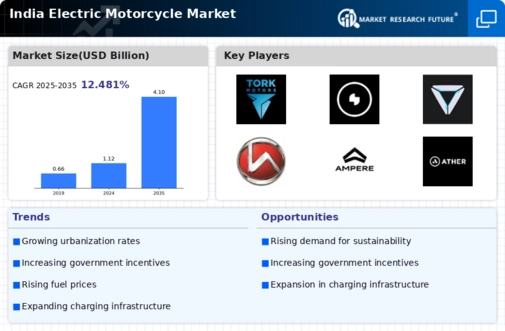Rising Environmental Awareness
Increasing environmental consciousness among consumers is a pivotal driver for the Global India Electric Motorcycle Market Industry. As urban pollution levels rise, there is a growing demand for cleaner transportation alternatives. Electric motorcycles, which produce zero tailpipe emissions, are becoming a preferred choice for eco-conscious consumers. This shift in consumer behavior is likely to accelerate market growth, with forecasts suggesting a remarkable increase in market size to 12 USD Billion by 2035. The emphasis on sustainable transportation solutions aligns with global trends towards reducing carbon footprints, further propelling the adoption of electric motorcycles in India.
Government Initiatives and Policies
The Global India Electric Motorcycle Market Industry is significantly influenced by various government initiatives aimed at promoting electric mobility. The Indian government has introduced policies such as the Faster Adoption and Manufacturing of Electric Vehicles (FAME) scheme, which incentivizes electric vehicle adoption through subsidies and tax benefits. These initiatives are expected to drive the market's growth, with projections indicating that the market could reach a valuation of 1.5 USD Billion in 2024. Such supportive measures not only enhance consumer confidence but also encourage manufacturers to invest in electric motorcycle technology, thereby fostering a conducive environment for market expansion.
Urbanization and Traffic Congestion
Rapid urbanization and increasing traffic congestion in Indian cities are driving the demand for electric motorcycles within the Global India Electric Motorcycle Market Industry. As urban populations swell, traditional modes of transportation are becoming less viable due to traffic jams and limited parking spaces. Electric motorcycles offer a practical solution, providing maneuverability and ease of parking. This trend is likely to contribute to the market's expansion, as consumers seek efficient alternatives to navigate congested urban environments. The growing preference for electric motorcycles as a solution to urban mobility challenges is expected to play a significant role in shaping the industry's future.
Cost-Effectiveness and Lower Operating Costs
The cost-effectiveness of electric motorcycles is a significant driver for the Global India Electric Motorcycle Market Industry. With lower operating costs compared to traditional gasoline-powered vehicles, electric motorcycles present an attractive option for budget-conscious consumers. The reduced expenses associated with fuel and maintenance make electric motorcycles a financially viable choice. As the market matures, the total cost of ownership is expected to decrease further, enhancing their appeal. This economic advantage is likely to stimulate demand, contributing to the anticipated market growth trajectory, with projections indicating a market size of 12 USD Billion by 2035.
Technological Advancements in Battery Technology
Advancements in battery technology play a crucial role in shaping the Global India Electric Motorcycle Market Industry. Innovations such as lithium-ion batteries and solid-state batteries are enhancing the performance and efficiency of electric motorcycles. These improvements lead to longer ranges and shorter charging times, addressing consumer concerns regarding usability. As manufacturers adopt these technologies, the market is expected to witness substantial growth, with a projected CAGR of 20.81% from 2025 to 2035. This technological evolution not only boosts consumer confidence but also attracts investments in the electric motorcycle sector, thereby fostering a competitive landscape.




















Leave a Comment